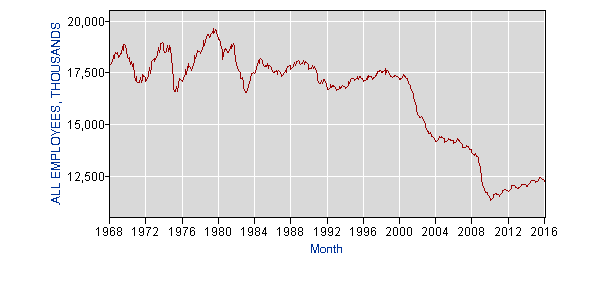July 07, 2016
Adam Davidson had an interesting NYT Magazine piece on Donald Trump and the central Pennsylvania economy. His basic point, that Trump’s proposals for high tariffs will not revitalize the region is undoubtedly correct, but there are a few points that should be made.
First, productivity and technological change has been far more important for jobs in manufacturing than trade, but that doesn’t mean trade has not still been a big deal. We have seen rapid productivity growth in manufacturing through the whole post-war period, but the number of jobs in the sector remained roughly constant, with cyclical fluctuations, from the late 1960s until the end of the 1990s. Since the labor force was growing over this period, it did mean that the manufacturing share of employment was falling.
However, the absolute number of jobs plummeted at the start of the last decade as the trade deficit exploded. The drop was more than 20 percent even before the 2008 recession.
Jobs in Manufacturing
 Source: Bureau of Labor Statistics.
Source: Bureau of Labor Statistics.
This sharp decline in manufacturing employment had negative effects in many regions of the country, although it’s possible that the impact in central Pennsylvania was less than in other manufacturing regions. Also, the threat of job loss, often due to trade, is an important factor affecting workers’ bargaining power and therefore their ability to secure pay increases.
There is also important point that, while it may not be possible to bring back lost jobs, we are still losing jobs to trade. The trade deficit with China rose from $319 billion in 2013 to $367 billion in 2015. This rise in the deficit would correspond to more than 400,000 manufacturing jobs. It may not be possible to bring back jobs already lost to China, but it is possible to reduce the rate at which the country loses jobs to China.
Trump’s tariffs might not be the best way to accomplish that result, but if China substantially raised the value of its currency against the dollar, it would make U.S. goods and services relatively more competitive. Although few economists would endorse imposing high tariffs, many would in fact support measures that led China to raise the value of its currency, including some like Fred Bergsten who are strongly supportive of “free trade.” (Bergsten is the former president of Peterson Institute for International Economics.)
The piece also identifies an investment by a Japanese company, Nippon Electric Glass, into a local glass company as an example of the area benefiting from trade. This may be the case, but we need more information on the topic to make this judgement.
Trade and direct investment are often alternative ways to enter a market. For example, the Japanese auto manufacturers began to locate factories in the United States in response to measures that limited their exports to the U.S. It is possible that the investment by Nippon Electric Glass was associated with a surge of imports of supplies from Japan. However, it may also be the case that the company simply saw direct investment as the best way to enter the U.S. market. If the latter is the case, then this is not an example of the region benefiting from trade, although it did benefit from being part of the international economy.







Comments